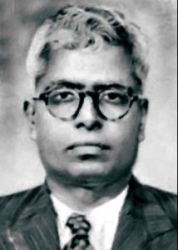Subbayya Sivasankaranarayana Pillai
| Subbayya Sivasankaranarayana Pillai | |
|---|---|
 |
|
| Born | April 5, 1901 Nagercoil, Kingdom of Travancore (in present day Tamil Nadu) |
| Died | 31 August 1950 Cairo, Egypt |
| Nationality | Indian |
| Known for | |
| Scientific career | |
| Fields | Mathematics |
Subbayya Sivasankaranarayana Pillai (1901–1950) was an Nagercoil native Indian mathematician specialising in number theory. His contribution to Waring's problem was described in 1950 by K. S. Chandrasekharan as "almost certainly his best piece of work and one of the very best achievements in Indian Mathematics since Ramanujan".
Subbayya Sivasankaranarayana Pillai was born to parents Subbayya Pillai and Gomati Ammal who were natives of Nagercoil. His mother died a year after his birth and his father when Pillai was in his last year at school.
Pillai did his Intermediate course in the Scott Christian College at Nagercoil and managed to earn a B.A. degree from Maharaja's college, Trivandrum.
In 1927, Pillai was awarded a research fellowship at the University of Madras to work among professors K. Ananda Rau and Ramaswamy S. Vaidyanathaswamy. He was from 1929 to 1941 at Annamalai University where he worked as a lecturer. It was in Annamalai University that he did his major work in Waring's problem. In 1941 he went to the University of Travancore and a year later to the University of Calcutta as a lecturer (where he was at the invitation of Friedrich Wilhelm Levi).
For his achievements he was invited in August 1950, for a year to visit the Institute for Advanced Study, Princeton, USA. He was also invited to participate in the International Congress of Mathematicians at Harvard University as a delegate of the Madras University but he died during the crash of TWA Flight 903 in Egypt on the way to the conference.
...
Wikipedia
